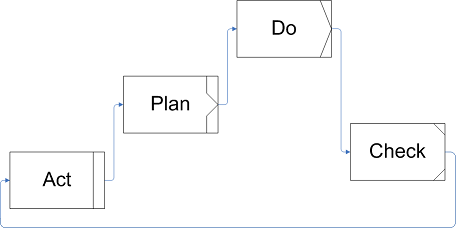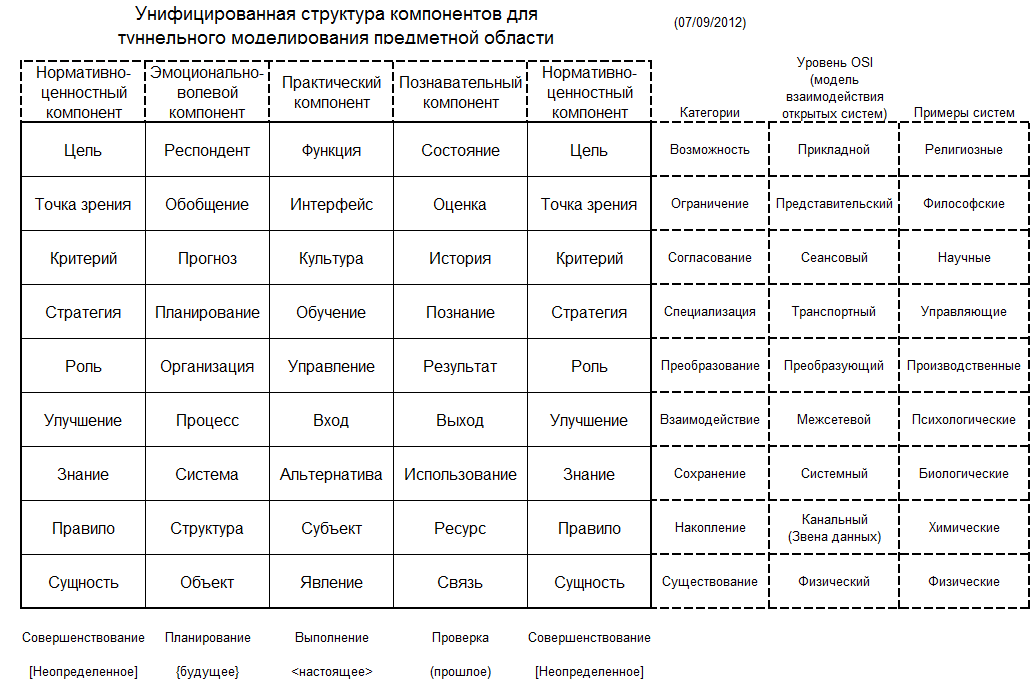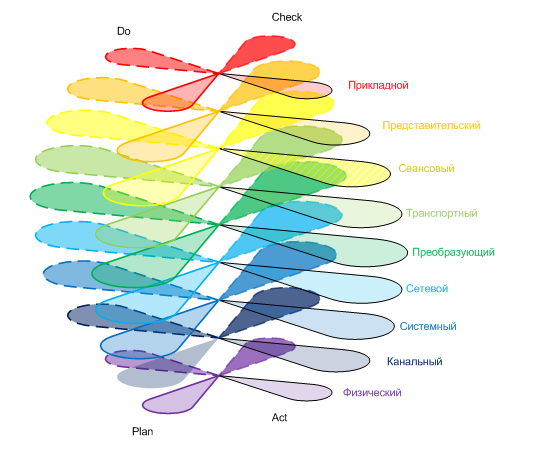Open Systems Interconnection Model, Deming Cycle and Tunnel Modeling
Good time to read, dear members habrahabr.ru
The idea of tunnel simulation is based on the combination of two ideas.
- the modernized nine-level model of open systems interaction ( http://habrahabr.ru/post/176249/ )
and
- Deming's cycle Plan-Do-Check-Act, which is included in the standard GOST R ISO 9001.
The Deming cycle creates a circular coordinate system in which each phase of the cycle corresponds to a separate quadrant.
')
Let us reveal the intrigue of the name - about tunnel modeling.
Put the actant (using the terminology of UML - Unified software development process) at the center of the Deming cycle, and up and down (assuming that the actant is at a transformative level - 50% abstract), we will erect a circular wall from the Deming cycle itself.
As a result, the observer will be in half full glass. By adding or subtracting the level of water in which the observer flounders, we can examine various levels of abstraction — the levels of the (modernized) BOC model — to build a specific model of something under investigation. I will not argue that I already know how to build such a model - this requires the opinion of the scientific community about what part of the existing knowledge to look for in a particular segment of the tunnel model. But I have a proposal based on an analysis of 700 terms from four standards.
Let's apply the graphic image in the style adopted in the SADT model (IDEF0 standard):

We write the sequence of elements of the Deming cycle in the form - Act-Plan-Do-Check-
A sweep of the nine-level open systems interconnection model on the Deming cycle might look like this:

Source - http://integral-community.ru/magazine/Integral-philosophy-mag2.pdf , p.86
In information technology, the Zachman model is known (see Zahman Systems Architecture ). The proposed model exceeds the Zachman model in dimension (36 vs. 30), but differs significantly in configuration (9x4 against 5x6). Comparing the compatibility of models is also a matter of the future.
In favor of the proposed presentation I can give a philosophical interpretation of this model:

Source - http://www.philosophystorm.org/palex/2893
The proposed three-dimensional interpretation - to generate ideas for 3D-programming

Literature and links:
Those who are most interested in the questions "Why are there nine levels, if there are seven OSI?" Or "How to apply it in programming" I ask to ask them in the subject by the levels of abstractness http://habrahabr.ru/post/176249
UPD: related topics
Abstraction and open systems interaction model habrahabr.ru/post/176249
Tunnel modeling v0.1 - pseudocode habrahabr.ru/post/176935
The idea of tunnel simulation is based on the combination of two ideas.
- the modernized nine-level model of open systems interaction ( http://habrahabr.ru/post/176249/ )
and
- Deming's cycle Plan-Do-Check-Act, which is included in the standard GOST R ISO 9001.
The Deming cycle creates a circular coordinate system in which each phase of the cycle corresponds to a separate quadrant.
')
Let us reveal the intrigue of the name - about tunnel modeling.
Put the actant (using the terminology of UML - Unified software development process) at the center of the Deming cycle, and up and down (assuming that the actant is at a transformative level - 50% abstract), we will erect a circular wall from the Deming cycle itself.
As a result, the observer will be in half full glass. By adding or subtracting the level of water in which the observer flounders, we can examine various levels of abstraction — the levels of the (modernized) BOC model — to build a specific model of something under investigation. I will not argue that I already know how to build such a model - this requires the opinion of the scientific community about what part of the existing knowledge to look for in a particular segment of the tunnel model. But I have a proposal based on an analysis of 700 terms from four standards.
Let's apply the graphic image in the style adopted in the SADT model (IDEF0 standard):

We write the sequence of elements of the Deming cycle in the form - Act-Plan-Do-Check-
A sweep of the nine-level open systems interconnection model on the Deming cycle might look like this:

Source - http://integral-community.ru/magazine/Integral-philosophy-mag2.pdf , p.86
In information technology, the Zachman model is known (see Zahman Systems Architecture ). The proposed model exceeds the Zachman model in dimension (36 vs. 30), but differs significantly in configuration (9x4 against 5x6). Comparing the compatibility of models is also a matter of the future.
In favor of the proposed presentation I can give a philosophical interpretation of this model:

Source - http://www.philosophystorm.org/palex/2893
The proposed three-dimensional interpretation - to generate ideas for 3D-programming

Literature and links:
- Danilin A., Slyusarenko A. Architecture and strategy. Yin and Yang Information Technology Enterprise, M., Internet-Un-Inform. Technology, 2005
- Chaadaev V.K. Business processes in communication companies. Eco-Trendz. 2004
- Jacobson A., Butch G., Rambo J. Unified software development process. - SPb .: Peter, 2002
- GOST R ISO 9001: 2008
- Deming Cycle - Wikipedia
- Leonid Chernyak, Systems Architecture by Zahman, Open Systems, No. 12, 2001. http://www.osp.ru/os/2001/12/180711/
- Suggestions for using the open systems interaction model for developing a universal programming language http://pl2-rainbow.livejournal.com/1520.html
- Bakanov M.I., Sheremet A.D. Theory of economic analysis: Textbook. - 4th ed., Ext. and pererab. - M .: Finance and Statistics, 1999
- David Mark, Clement McGowan. Methodology of structural analysis and design: Trans. from English M.: 1993
- Mogilevsky V.D. Methodology of systems: verbal approach / Separate econ.RAN; scientific - ed. Council of the publishing house “Economics”. - M .: OAO “Publishing house“ Economics ”, 1999 - (Systemic problems of Russia)
- A. A. Podorov. Tunnel Modeling of Unified Knowledge, Integral
Philosophy (Journal of the Integral Community), Issue No. 2, 2012, pp.81-96 http://integral-community.ru/magazine/Integral-philosophy-mag2.pdf
Those who are most interested in the questions "Why are there nine levels, if there are seven OSI?" Or "How to apply it in programming" I ask to ask them in the subject by the levels of abstractness http://habrahabr.ru/post/176249
UPD: related topics
Abstraction and open systems interaction model habrahabr.ru/post/176249
Tunnel modeling v0.1 - pseudocode habrahabr.ru/post/176935
Source: https://habr.com/ru/post/176391/
All Articles